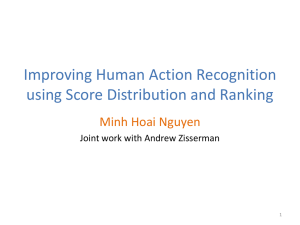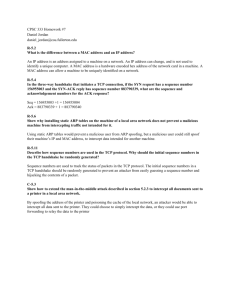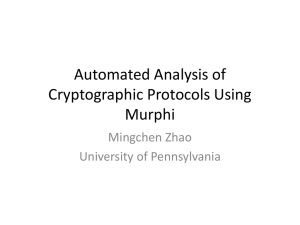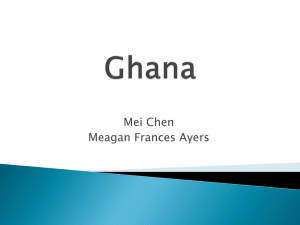doc - Stanford University`s Security Lab
advertisement
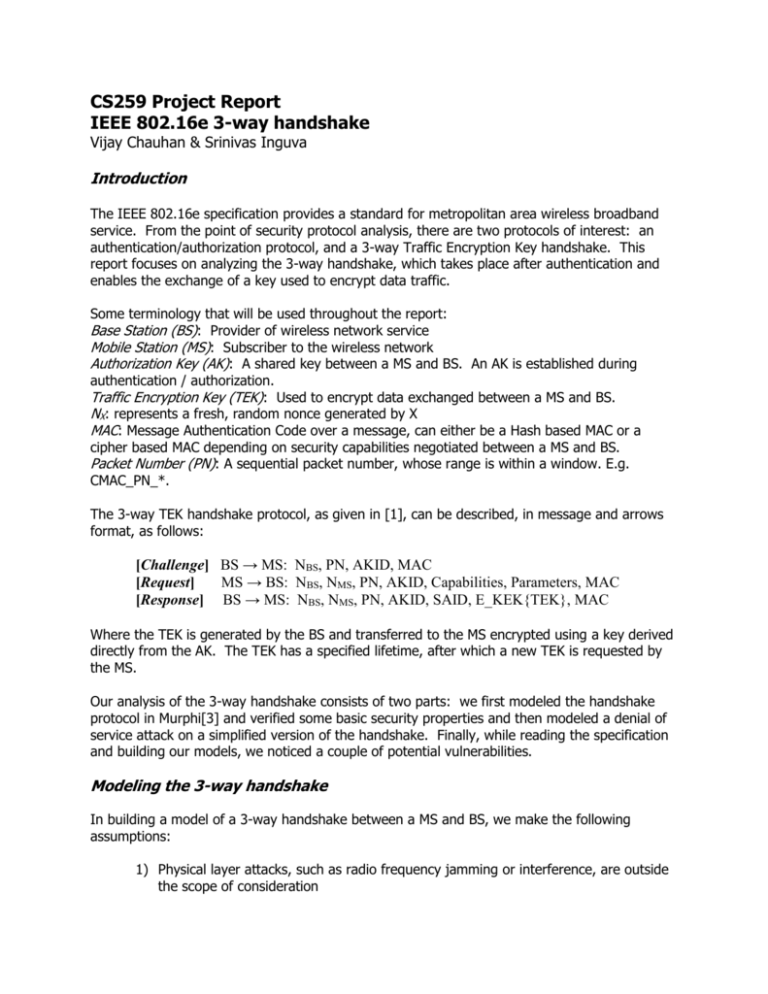
CS259 Project Report
IEEE 802.16e 3-way handshake
Vijay Chauhan & Srinivas Inguva
Introduction
The IEEE 802.16e specification provides a standard for metropolitan area wireless broadband
service. From the point of security protocol analysis, there are two protocols of interest: an
authentication/authorization protocol, and a 3-way Traffic Encryption Key handshake. This
report focuses on analyzing the 3-way handshake, which takes place after authentication and
enables the exchange of a key used to encrypt data traffic.
Some terminology that will be used throughout the report:
Base Station (BS): Provider of wireless network service
Mobile Station (MS): Subscriber to the wireless network
Authorization Key (AK): A shared key between a MS and BS. An AK is established during
authentication / authorization.
Traffic Encryption Key (TEK): Used to encrypt data exchanged between a MS and BS.
NX: represents a fresh, random nonce generated by X
MAC: Message Authentication Code over a message, can either be a Hash based MAC or a
cipher based MAC depending on security capabilities negotiated between a MS and BS.
Packet Number (PN): A sequential packet number, whose range is within a window. E.g.
CMAC_PN_*.
The 3-way TEK handshake protocol, as given in [1], can be described, in message and arrows
format, as follows:
[Challenge] BS → MS: NBS, PN, AKID, MAC
[Request]
MS → BS: NBS, NMS, PN, AKID, Capabilities, Parameters, MAC
[Response] BS → MS: NBS, NMS, PN, AKID, SAID, E_KEK{TEK}, MAC
Where the TEK is generated by the BS and transferred to the MS encrypted using a key derived
directly from the AK. The TEK has a specified lifetime, after which a new TEK is requested by
the MS.
Our analysis of the 3-way handshake consists of two parts: we first modeled the handshake
protocol in Murphi[3] and verified some basic security properties and then modeled a denial of
service attack on a simplified version of the handshake. Finally, while reading the specification
and building our models, we noticed a couple of potential vulnerabilities.
Modeling the 3-way handshake
In building a model of a 3-way handshake between a MS and BS, we make the following
assumptions:
1) Physical layer attacks, such as radio frequency jamming or interference, are outside
the scope of consideration
2) The MS and BS are securely authenticated and a shared AK is established (and
therefore the derived KEK and subsequent TEK are also shared and not revealed at
any stage during the handshake)
3) A Dolev-Yao attacker model. Our initial goal was to use Murphi to model the 3-way
handshake and verify some basic security properties. We did this using a “rational
reconstruction” approach: starting with a very simple protocol (just nonces) and
adding in MACs and PNs.
Our Murphi model involved three sets of participants: Mobile Stations, Base Stations, and
Intruders. Any given MS/BS pair can engage in multiple handshakes. Intruders are allowed to
perform the following actions:
1) Intercept and record messages
2) Replay whole messages
3) Create forged messages with known nonces/MACs. This is potentially an
unrealistically powerful intruder because the physical address is incorporated into the
MACs.
The security properties (Murphi invariants) we checked, at this point, were of two forms: “Does
the protocol execute as expected?” and “Are messages only accepted in the appropriate order?”
Invariants were written for each such expected MS/BS state machine transition.
An example of a Murphi invariant for determining whether a handshake, between a given
MS/BS pair, executed as expected is:
invariant "If MS is DONE => BS is DONE"
forall i: BSId do
forall j: MSId do
(ms[j].associations[i].session.state = MS_DONE &
(ms[j].associations[i].sid = bs[i].associations[j].sid))
->
(bs[i].associations[j].session.state = BS_DONE)
end
end;
This asserts that if a MS is done (in the MS_DONE state) then the associated BS is also done (in
the BS_DONE state).
An example of a Murphi invariant for determining whether handshake messages are only
accepted in the correct order, is:
invariant "If MS is WAIT_RES => BS is in WAIT_REQ/DONE"
forall i: BSId do
forall j: MSId do
(ms[j].associations[i].session.state = MS_WAIT_RES &
(ms[j].associations[i].sid = bs[i].associations[j].sid))
->
(!bs[i].associations[j].session.state = BS_START)
end
end;
This asserts that if a MS is waiting for a response then the associated BS cannot be in the start
state. A normally executing BS must have already sent a challenge message if the associated
MS is waiting for a response from it.
The simplified handshake protocol we modeled in Murphi was:
[Challenge] BS → MS: NBS, MAC
[Request]
MS → BS: NBS, NMS, MAC
[Response] BS → MS: NBS, NMS, NTEK, MAC
Note that given our assumption of a securely established AK (and therefore KEK and TEK) and a
Dolev-Yao intruder model, it would not be possible for an intruder to recover a TEK. So, we
modeled the encrypted TEK as a nonce.
As modeled, no attacks were found by Murphi. However, we observed that a denial of service
(DoS) attack was possible against this simplified protocol: An intruder can replay a previously
recorded challenge message to an MS, causing this MS to repeatedly engage in handshakes.
A natural question at this point was how to model this DoS attack in Murphi. It was not obvious
how to do this, because we needed a way to tabulate the cumulative effects of an attack over
time. To handle this, we considered a scenario which consisted of one MS/BS pair that expect
to engage in one handshake. This represents the common case of key exchange followed by
an extended period of encrypted data transfer.
In this scenario, after the handshake any work the MS/BS do beyond the “expected costs” (as a
result of intruder interference) is evidence of a potential DoS attack. Finally, we need a way to
programmatically, within Murphi, determine whether a DoS attack occurred. To achieve this,
we used ideas from Meadows [2].
Modeling a DoS attack in Murphi
We used the following general setup:
1) We created a “cost set” for protocol actions. These are costs attached with each of the
basic actions that take place in the protocol. These costs were based on [2]. Some
examples are generating a nonce, sending a message, etc.
2) We could now use this cost set to compute the total cost for complete actions in the
protocol such as composing and sending the challenge, receiving and verifying the
challenge, etc.
3) These action costs were then incorporated into the Murphi state transition rules for the
MS/BS such that we could monitor the costs at every stage of the protocol.
4) Based on the expected costs for a legitimate run of the handshake and based on the
cost set for an attacker, we determined threshold minimum costs for an attacker and
maximum costs for an honest principal for classification of a DoS. The basic idea is to be
able to spot when the attacker has not had to expend “much” energy to cause a
defender to expend “a lot” of energy. Here we are trying to quantify “much” and “a lot”.
5) The above thresholds were incorporated into Murphi invariants to allow us to spot DoS
attacks.
Here is a summary of the exact action costs used:
Cost Set = {1=Cheap, 2=Medium, 3=Expensive}
Basic honest operations and their costs:
- Generate Nonce
=1
- Generate/Verify MAC
=2
- Encrypt/Decrypt TEK
=3
- Send/Receive
=3
Basic intruder operations and their costs:
- Store/Lookup
=1
- Send/Receive
=3
- Assemble message
=1
Based on these action costs we derived the costs attached with each message in the handshake
for the MS/BS:
→
→
→
→
→
→
BS
MS
BS
MS
BS
MS
genNonce, genMAC, send
recv, verMAC
genNonce, genMAC, send
recv, verMAC
buildTEK, genMAC, send
recv, verMAC, decryptTEK
[6]
[5]
[6]
[5]
[8]
[8]
Likewise for the Intruder Actions:
•
•
•
Intercept Message:
Replay Message:
Compose Message:
recv, store
lookup, send
assemble, send
[4]
[4]
[4]
The above costs were used to come up with thresholds which were then incorporated into
Murphi invariants to allow us to spot DoS attacks. Here is an example of such an invariant. The
invariant fails when cost for the MS is above some threshold (MS_PROTOCOL_COSTS) and the
attacker costs are below some threshold (INT_THRESHOLD):
-- If MS is done => MS costs = RecvCLG + SendREQ + RecvRES
invariant "If MS is DONE => costs <= MS_PROTOCOL_COSTS and
intCosts > INT_THRESHOLD"
forall i: BSId do
forall j: MSId do
(ms[j].associations[i].session.state = MS_DONE)
->
(ms[j].associations[i].session.costs <= MS_PROTOCOL_COSTS |
ms[j].associations[i].session.intCosts > INT_THRESHOLD)
end
end;
The above invariant failed and indicated that an intruder can cause a BS/MS pair to re-engage
in a 3-way handshake by replaying the Challenge message. Continuously replaying the
Challenge could thus lead to the MS/BS pair constantly re-keying without the transfer of any
useful data.
As per rational reconstruction we realized that either this is a true vulnerability or that there
must be some additional mechanism that prevents the DoS attack. Looking deeper into the
specification highlighted that some sort of PN (Packet Number) was necessary to prevent
replay. The PN itself is MAC’d preventing modification. After updating our Murphi model to
include PNs, as expected, the attack was no longer seen.
Potential Vulnerabilities in the 802.16e specification
During the process of rational reconstruction to build up a more and more accurate model of
the 802.16e 3-way handshake protocol, we inevitably needed to look at the specification in
greater and greater depth. When investigating PNs we noticed that before authentication,
certain security capabilities are negotiated in the clear. For example the PN_WINDOW_SIZE and
the Authentication Protocol version number. In the event that an intruder was able to intercept
and modify messages with these capabilities in real-time, an intruder could do the following.
1) If the PN_WINDOW_SIZE is set to 0, the valid range of PNs accepted by the honest
principals would be empty and could potentially lead to a DoS if AES-CCM is used for
encryption (Section 7.5.1.2.4 [1]). A potential solution to this attack could be to
recheck the value after authentication and fail if different from the value initially
negotiated. While this could still allow an intruder to cause a DoS, it would atleast be
apparent that a DoS was taking place.
2) PKM Version rollback may be possible if the version number can be modified from
PKMv2 to PKMv1. The reduced security of PKMv1 could lead to further attacks. It is
unclear what level of support implementers of PKMv2 need to provide for PKMv1. If
PKMv1 is simply deprecated there is no need to provide backwards compatibility and
hence version rollback in this case can be prevented.
Conclusions
After our investigations it appears that the 3-way handshake is a well-designed protocol which
has learnt from the lessons of 802.11i. In particular 802.16e is not susceptible to the types of
attacks seen in 802.11i[4]. One of the main reasons is that the first message (Challenge) is
MAC’d ensuring the integrity of the message.
We have been able to produce an accurate model of the handshake protocol through the
process of rational reconstruction. The model incorporates the essential elements of the
handshake and then builds up additional security mechanisms such as MACs and PNs which
prevent certain types of attacks.
We employed a simple and effective method to model DoS attacks in Murphi. We believe that
our technique can be extended to other protocols assuming that we can compute approximate
protocol action costs and attacker cost thresholds.
References
[1] The Institute of Electrical and Electronics Engineers. IEEE Standard for Local and Metropolitan Area Networks Part
16: Air Interface for Fixed Broadband Wireless Access Systems—Amendment for Physical and Medium Access Control
Layers for Combined Fixed and Mobile Operation in Licensed Bands, IEEE Std 802.16e/D11. IEEE 2005.
[2] A Cost-Based Framework for Analysis of Denial of Service in Networks (2000) - Catherine Meadows, Journal of
Computer Security.
[3] Murphi protocol description language - http://verify.stanford.edu/dill/murphi.html
[4] Changhua He, John C. Mitchell. Security analysis and improvements for IEEE 802.11i. The 12th Annual Network
and Distributed System Security Symposium (NDSS'05), pages 90-110. Feb. 2005

